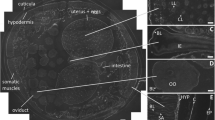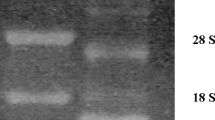Abstract.
Organisms co-habiting with bacteria have developed efficient bactericidal agents to control their microbe-rich environment. The Ascaris nematode lives in its final development stages in the gut of its host and is believed to feed on bacteria. Ascaris suum survive in pig intestine while A. lumbricoides is the principal species in humans. Here we show that A. suum and A. lumbricoides both produce linear (cecropin P1) and cysteine-rich (ASABF) peptides with activity against either Gram-negative or Gram-positive bacteria, respectively. Thus nematodes rely in part on a peptide-based antibacterial system for digestion of bacteria, which may also confer protection against infection. Cecropin P1 was previously isolated from pig intestine but we can now conclude that was due to contaminating nematodes.
Similar content being viewed by others
Author information
Authors and Affiliations
Additional information
Received 17 December 2002; received after revision 28 January 2003; accepted 28 January 2003
RID="*"
ID="*"Corresponding author.
Rights and permissions
About this article
Cite this article
Andersson, M., Boman, A. & Boman, H. Ascaris nematodes from pig and human make three anti-bacterial peptides: isolation of cecropin P1 and two ASABF peptides. CMLS, Cell. Mol. Life Sci. 60, 599–606 (2003). https://doi.org/10.1007/s000180300051
Issue Date:
DOI: https://doi.org/10.1007/s000180300051




